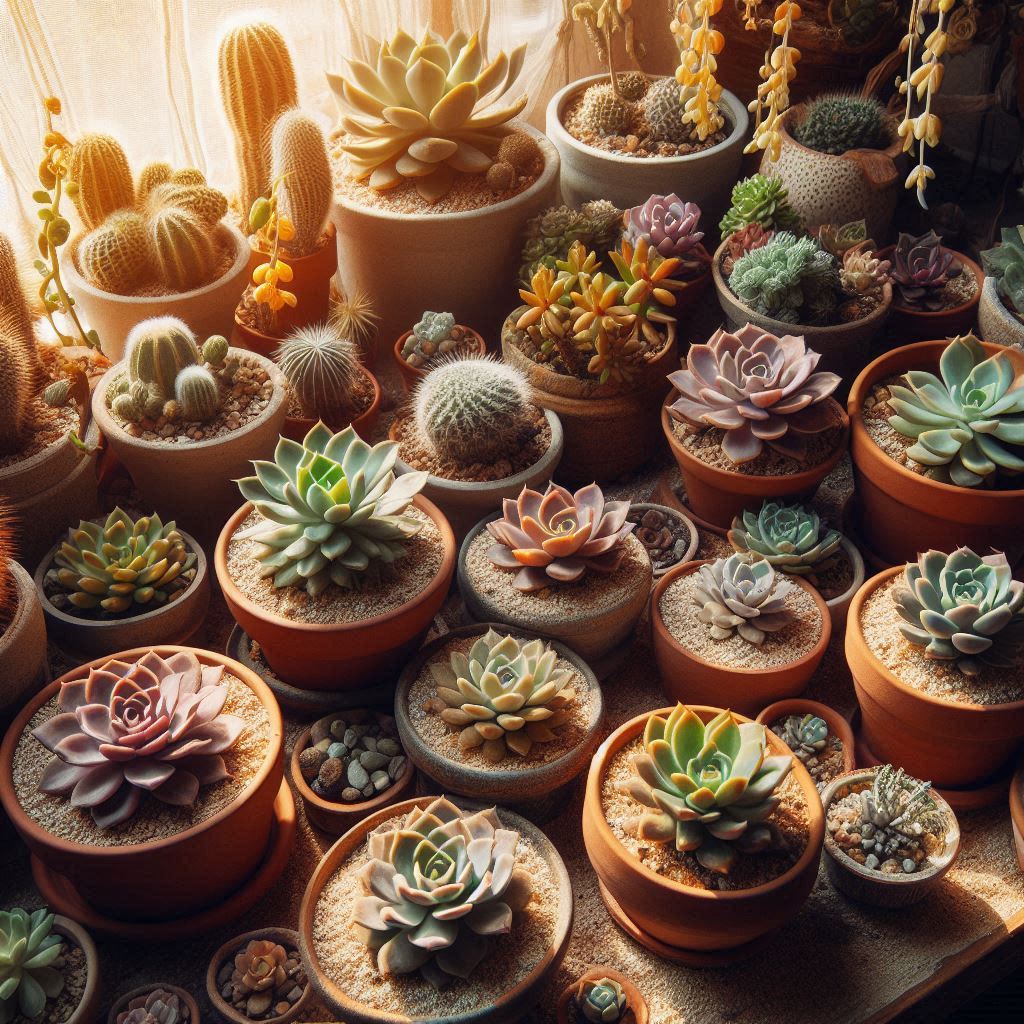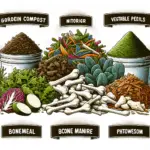Do deer eat succulents? If you’re a gardener or succulent enthusiast, this question might have crossed your mind. Understanding deer feeding habits can help protect your beloved plants. Deer, known for their diverse diet, occasionally nibble on unexpected garden items, including succulents. Explore ways to prevent deer from turning your garden into their salad bar with our comprehensive guide.
Do Deer Naturally Feed on Succulents?
Deer have a natural inclination to browse a wide variety of plants, but do they naturally feed on succulents? Succulents, with their fleshy leaves filled with water, are not a deer’s first choice, especially given their texture and typical bitter taste. In general, deer tend to prefer softer, more palatable plants like tender shoots and leaves from non-succulent plants.
However, during periods of food scarcity, such as droughts or in harsh winter months, deer might be tempted to eat succulents if more appealing options are unavailable. Succulents can sometimes provide vital hydration, thanks to their high water content, making them an occasional target when other water sources are scarce.
It’s important to note that the feeding habits of deer can vary regionally and seasonally, influenced by local environmental conditions and the availability of other food sources. While some succulent varieties might sustain minor damage, they are generally not the primary targets, unlike other more attractive plants to deer. Gardeners should remain cautious and observe local deer behaviors to determine the risk to their succulent plants.
Which Succulent Varieties Are Most Likely to Be Eaten by Deer?
Different succulent varieties exhibit varying levels of vulnerability to deer. Certain types are tastier or easier to graze on, making them more attractive to these animals. Understanding which succulents are most susceptible can help protect your garden from unexpected feasting.
Aeoniums
These striking rosettes are often targeted by deer due to their fleshy leaves. Aeoniums’ tender texture makes them quite tempting, leading to frequent munching if not properly safeguarded.
Sedums
Known for their wide range of shapes and colors, Sedums can fall prey to deer, especially the soft-leaved varieties. While some Sedums are more resistant, others in the family may require additional protection.
Echeverias
The vibrant and colorful Echeverias can unfortunately attract deer. Their appealing, juicy leaves provide a satisfying snack, so extra care should be taken to defend these plants.
As deer forage, they often look for easy meals, and certain succulents fit this bill too well. Recognizing which types are most likely to be eaten is a crucial step in maintaining a deer-resistant garden. Monitoring your garden closely and taking preventive measures can help mitigate the damage caused by these unwelcome visitors.
How to Protect Your Succulents from Deer
To keep your succulents safe from deer, consider implementing several strategic methods. Start by installing a physical barrier such as a fence. Ensure the fence is at least eight feet tall to effectively deter deer, as they can jump quite high. You can also try adding netting over smaller succulent patches.
Another effective solution is using deer repellents. Look for commercial deer repellents that are safe for plants. These products usually contain strong smells or tastes that are unappealing to deer. Apply them around the perimeter of your garden or directly on the plants, following the product instructions.
Incorporating deer-resistant plants is another clever approach. Consider planting varieties that deer typically avoid due to their taste or texture, such as foxgloves or lavender. These can act as natural barriers around your succulent garden.
Deer are creatures of habit, so disturbing their routine can be effective. Incorporate motion-activated sprinklers or lights to startle deer and drive them away. These devices can effectively disrupt deer behavior and keep them from grazing on your plants.
Maintaining a clean garden also helps. Clear fallen fruit and avoid using deer-attracting mulches like wood chips, which can inadvertently invite deer to visit your garden more frequently.
Finally, don’t underestimate the power of community. Share tips and tricks with neighbors, collaborate on larger-scale deterrents, and keep an eye out for deer in the neighborhood. Often, what works for one garden can benefit another.
Are Succulents a Preferred Food Source for Deer?
Deer have diverse diets depending on availability, but are succulents a preferred food source? Succulents are not typically high on the deer’s menu due to their tough, fleshy leaves and often bitter taste. However, in certain conditions, especially during food scarcity, deer may nibble on succulents.
Factors Influencing Deer Preferences
The availability of other, more appealing food sources plays a significant role in whether deer target succulents. When their preferred browse, like tender shoots or leaves, is scarce, deer may explore less desirable plants including some succulent varieties. Additionally, young deer might trial different plants as they learn which are edible and which are not.
Weather and environmental changes can also impact deer feeding habits. In harsh conditions, such as extended droughts or extreme cold, vegetation is less accessible, prompting deer to expand their dietary options, occasionally including succulents.
While not generally preferred, understanding these dynamics enables gardeners to make informed decisions about protecting their succulents from occasional deer foraging. Implementing preventative measures can further enhance the resilience of your succulent garden.
Deer-Resistant Succulent Varieties for Your Garden
Looking to safeguard your garden from deer without compromising on aesthetics? Consider incorporating deer-resistant succulents into your landscape. These hardy plants not only offer a wide range of textures and colors but are also less appetizing to deer, making them an excellent choice for gardens frequented by these animals.
Available Varieties
Several succulent species are known for their deer resistance. Agave, with its spiky leaves and sturdy structure, typically deters deer from grazing. Hens and chicks (Sempervivum) offer a charming, rosette-like appearance and are seldom touched by deer. Aeonium varieties provide beautiful forms and are generally not favored by deer due to their mildly toxic nature.
Benefits of Deer-Resistant Succulents
These succulents not only reduce the likelihood of deer damage but also require minimal maintenance, are drought-resistant, and thrive in various climates. By choosing the right succulents, you maintain a robust and beautiful garden that is resilient against deer browsing, ensuring that your outdoor space remains intact and vibrant throughout the year.
Strategic Planting Placing deer-resistant succulents around the garden border creates a natural barrier, further dissuading deer from venturing into more attractive areas of your garden. Layering different varieties not only enhances visual appeal but also strengthens the deterrent effect.
Why Deer Might Eat Succulents in Certain Conditions
Deer are known to adapt their eating habits based on available food sources, which can lead them to consume succulents in specific situations. While succulents are not typically their preferred choice, certain environmental factors can encourage them to sample these fleshy plants. During periods of drought or when food is scarce, deer might turn to succulents for their moisture content. These plants can provide hydration, making them an attractive option when water sources are limited. Additionally, if a garden lacks other food sources, succulents might find their way into a deer’s diet.
Another reason deer might eat succulents is the presence of young or tender plants. Newly planted succulents or those with fresh growth can be more appealing to deer due to their softer texture and higher water content. Gardens that border areas with high deer populations are particularly susceptible to these feeding behaviors.
Moreover, seasonal changes play a significant role in what deer choose to eat. In the winter months, when natural vegetation is sparse, deer are more likely to experiment with different plants, including succulents. Gardeners should take these conditions into account when planning their landscapes.
Understanding the environmental and situational factors that lead deer to eat succulents can help gardeners implement strategies to protect their plants. Awareness of these conditions allows for better planning of which varieties to plant and how to safeguard them effectively.
Signs That Deer Have Been Eating Your Succulents
Spotting signs that deer have been eating your succulents involves looking for specific indicators in your garden. One of the most apparent signs is the presence of jagged edges on the leaves of your plants. Deer have no upper front teeth, so they often leave a ragged cut on the foliage. Check for hoof prints in the soil around your succulents, especially after the rain when the ground is softer. Deer tracks are cloven and may vary in size depending on the species.
Another sign to look for is the presence of deer droppings nearby. These are small, pellet-like, and can be found close to the plants they have been nibbling on. If you notice that your succulents are getting uprooted or knocked over, it might be due to deer’s foraging habits, as they can be quite clumsy while browsing.
Also, observe if there are any branches or stems that appear chewed off, typically higher from the ground than other small animals could reach. Disturbed soil and trampling are tell-tale signs that deer have been frequenting your garden, leaving evident trails through dense foliage. By recognizing these signs early, you can take necessary actions to protect your beloved succulents from future nibbling.
Creating a Deer-Proof Garden with Succulents
- Selecting the Right Succulents: Choose deer-resistant succulents like agave, yucca, and euphorbia. These are often unappealing to deer due to their thick skins, sharp spines, or bitter taste.
- Creating Barriers: Use physical barriers like fences or netting to deter deer. A well-placed barrier not only protects your garden but also adds an extra layer of landscape design.
- Incorporating Deer-Repellant Plants: Integrate plants that deer dislike, such as lavender or rosemary, around your succulents. The strong scent can help to mask the succulents and deter deer.
- Using Natural Repellents: Apply natural deer repellents like homemade sprays or commercial solutions. Regular application around your succulent garden edge can keep deer at bay.
- Maintaining Your Garden: Regular upkeep of your garden can make it less appealing to deer. Remove fallen fruit and dead plants that might attract them.
- Understanding Deer Patterns: Observe deer movement and feeding patterns to adjust your gardening strategies. Knowing when and how they attack can help in reinforcing your garden’s defenses.
Implementing these strategies not only safeguards your succulents against deer but also enhances the overall appeal and maintenance of your garden. By focusing on deer-resistant plants and protective measures, your thriving garden can withstand these curious guests.
Common Misconceptions About Deer and Succulents

There are several myths about deer and succulent plants that can lead to confusion for gardeners trying to protect their green spaces. One widespread misconception is that deer do not eat succulents at all. While succulents might not be a favorite for every deer, they can still be a part of their diet depending on circumstances. It’s crucial to recognize that deer, driven by hunger and availability of food sources, may turn to succulents even if they are not their first choice.
Another common misunderstanding is that all succulents are deer-resistant. This belief stems from the idea that the thick, sometimes spiny foliage of succulents deters deer. In reality, deer have been known to nibble on certain types of succulents, particularly during periods of food scarcity or drought.
It’s also a common belief that physical barriers are the only solution to deer challenges. However, this is not entirely true. While fencing is effective, incorporating deer-resistant succulent varieties and using repellents can significantly reduce the risk of deer feasting on your plants.
Clarifying These Misconceptions
By understanding these common misconceptions, gardeners can make informed decisions about how best to protect their succulent gardens without relying on inaccurate information. It’s important to assess the specific conditions of your garden and the types of succulents you have when considering deer prevention strategies.
Environmental Factors That Influence Deer Feeding Habits
Deer feeding habits are significantly shaped by environmental factors, which can influence whether they decide to munch on your precious succulents. One key aspect is the availability of alternative food sources. In areas where natural food is scarce, deer are more inclined to explore new food options, including succulents. This is often the case during harsh winter months when vegetation is limited.
Seasonal changes also play a crucial role. During spring and summer, when food is abundant, deer might show less interest in succulents. However, come fall and winter, when their regular diet becomes limited, succulents might suddenly seem appealing. Additionally, weather patterns, such as droughts, can make succulent plants one of the few viable moisture sources for deer, tempting them into gardens.
Habitat fragmentation can force deer populations closer to urban or suburban areas, thereby increasing their interactions with backyard gardens. If succulents are one of the few available plants, deer are more likely to snack on them. Likewise, proximity to forests or natural deer habitats can increase the chance of succulents making it onto a deer’s menu.
Human activity can disrupt the local ecosystem, sometimes making it more challenging for deer to find their usual food. In such environments, the landscaping choices of homeowners, including the planting of succulents, can unintentionally provide an alternative food source. It’s important to consider these environmental factors when planning a garden in deer-populated regions.
Alternatives to Succulents in Areas with High Deer Populations
In regions where deer populations are high and succulents are at constant risk of being eaten, gardeners might consider alternative plants that are less appealing to deer. While succulents are generally low-maintenance and drought-tolerant, their allure to deer can be a challenge. Here are some effective alternatives:
Lavender
Lavender not only adds beautiful color and fragrance to your garden, but its strong scent is also known to repel deer. Its hardiness and drought resistance make it a great substitute for succulents.
Russian Sage
Russian Sage is another excellent option. Its silvery foliage and blue blossoms resemble some succulent varieties, and its aroma is typically off-putting to deer.
Purple Coneflower
Purple coneflowers are not only deer-resistant but also attract beneficial pollinators like bees and butterflies. Their vibrant blooms add a punch of color similar to some succulent flowers.
Snow-in-Summer
For those who enjoy groundcovers, Snow-in-Summer is an ideal choice. This plant forms a dense mat that deer usually avoid, and it retains its beauty throughout various seasons.
By incorporating these alternative options, gardeners can create a lush and vibrant landscape that deters deer and reduces the risk of losing precious plants. Additionally, combining these plants with deer-repellent strategies can further enhance your garden’s resistance to unwelcome visitors.
How to Use Repellents to Prevent Deer from Eating Succulents
When it comes to protecting your garden, using repellents can be an effective strategy to deter deer from munching on your succulents. There are various types of repellents available, including both natural and chemical options. Natural repellents often consist of ingredients like garlic, eggs, or peppermint, which work by overwhelming the deer’s sense of smell, making your succulents unappealing. On the other hand, chemical repellents may contain ingredients that taste bitter or smell unpleasant to deer.
For optimal results, apply repellents regularly, especially after rain, as water can wash away the protective barrier. It’s crucial to
change repellent types periodically
, since deer can become accustomed or immune to a single kind if used too often. Consider using a combination of repellents to vary the stimuli.
Besides applying repellent directly on plants, treat the surrounding areas to create a comprehensive shield against hungry deer. Using repellents in conjunction with fencing or netting can further safeguard your succulents. While repellents are helpful, they are part of a broader strategy needed to effectively keep deer at bay, ensuring the long-term safety of your succulents.
Many gardeners wonder about the relationship between deer and succulents. While deer do not naturally feed on these plants, they might consume them when their preferred food sources are scarce. Environmental factors, such as drought or habitat loss, can sometimes lead deer to explore alternative food options.
When considering succulent varieties, some types are more likely to be eaten by deer, especially those with tender leaves. However, certain species, thanks to their texture or taste, are often avoided by deer. Understanding which varieties are vulnerable helps in planning a safe garden.
Protecting your succulents is essential if deer are common in your area. Techniques like using deer repellents or establishing physical barriers can effectively deter them. Additionally, strategic planting of deer-resistant varieties can serve as a natural deterrent.
If deer have been frequenting your garden, you may notice tell-tale signs such as missing leaves or hoof prints. Observant monitoring is key to addressing any potential issues early on. Knowing these indicators can help in swiftly applying solutions to safeguard your plants.
Misconceptions often arise about deer behavior towards succulents. It’s crucial to differentiate between occasional bites and regular feeding habits. This understanding aids in making informed decisions about gardening in deer-populated regions.
When designing a deer-proof garden, consider incorporating elements that naturally repel these animals. Some alternatives to succulents might suit certain areas better, especially where deer populations are particularly high.







